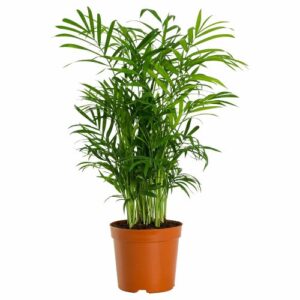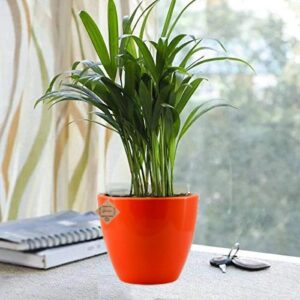Do you want to create a tropical vibe at your home? Areca palm plant is your only answer!
This blog will tell you about growing, caring tips and will answer frequently asked questions by gardeners like you!
Buy Areca Palm Plant Online
Areca Palm Plant Key Facts
Areca palm (Chrysalidocarpus lutescens) is one of the ideal picks for those who want to go for colorful interiors. It has arching, feathery fronds with up to 100 leaflets apiece. These large, striking plants draw a lot of attention.
Each year, the Areca Palm plant types grow 6 to 10 inches (15 to 25 cm) until it reaches a mature height of 6 or 7 feet (1.8 or 2.1 m.). The Areca palm is one of the few palms that one can prune without causing major damage, allowing mature plants to be kept indoors for up to ten years.
| Common Name | Areca palm, bamboo palm, yellow palm, golden cane palm |
| Botanical Name | Dypsis lutescens (formerly Chrysalidocarpus lutescens) |
| Family | Arecaceae |
| Size | 20-25 feet tall, 10-20 feet wide |
| Sunlight | Full, partial |
| Soil | Moist, Well-drained |
| Flower | Pale Yellow |
| Native Area | Madagascar |
If you are wondering, are there any areca palm plant benefits? Yes, there are, and we will cover that aspect too.
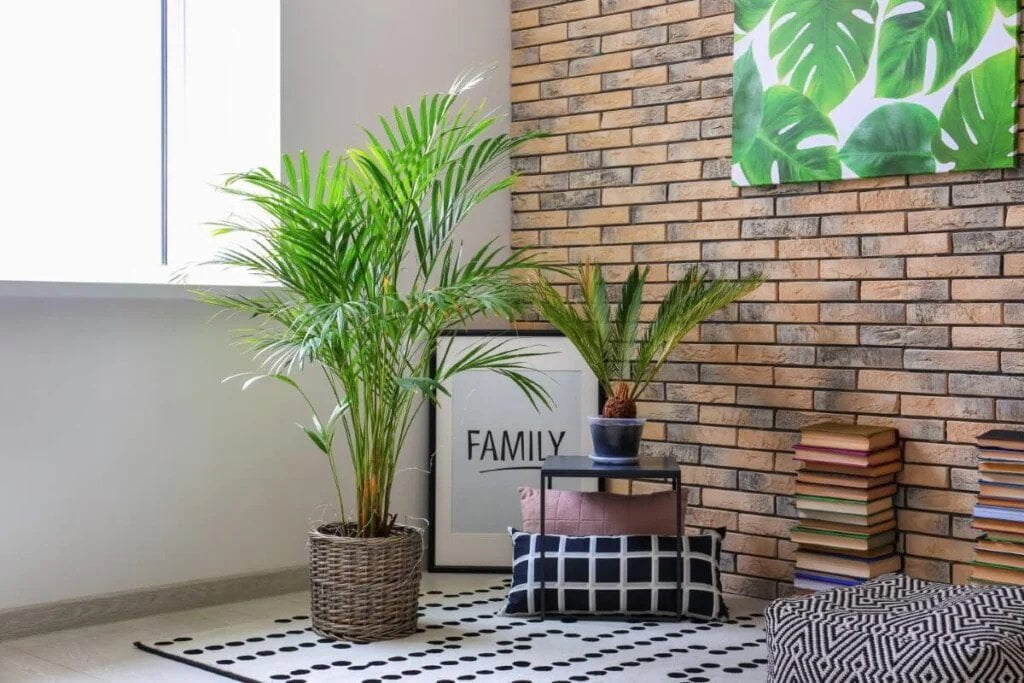
Areca Palm Plant Benefits
- The areca palm is very good at cleansing the air in the house. According to studies, the areca palm removes the sixth most formaldehyde from plants.
- It also has the capability of acting as a humidifier. It is ideal for people with asthma, allergies, or other respiratory problems.
- It has an appealing aura that captures everyone’s heart.
Now, we will cover Areca palm plant propagation.
Propagating Areca Palm Plant
Two ways can propagate areca palms:
- From seed
- Or dividing an existing plant.
From Seed
This procedure does take some time. Seeds should germinate in about six weeks, and plants should take several years to reach three or four feet in height.
You can plant fresh seeds straight soon if you have them on hand. Other than that, a few further measures are required to boost germination rates.
- You must scarify the seeds before being planted.
- Rub seeds against a mesh screen or sandpaper, then rinse them with water.
- After that, soak the seeds in white vinegar for a few hours before draining and rinsing in fresh water.
- Fill three-inch pots with a potting mix ideal for palms when the seeds are ready to sow.
- Wet the pot until it is moist but not soaked.
- Place one seed in each pot, just peeping out of the soil at the tip.
- Give the pots a final spritz of water and maintain them in an area where the temperature is consistently between 80 and 85 degrees Fahrenheit, or on a heat mat, occasionally misting to keep the potting media moist but not soggy.
- Replant into larger pots once a few leaves have developed and the seedlings are three to four inches tall.
- To achieve a more bushy, “full” appearance, gardeners prefer to plant three to four seedlings in one 12-inch pot.
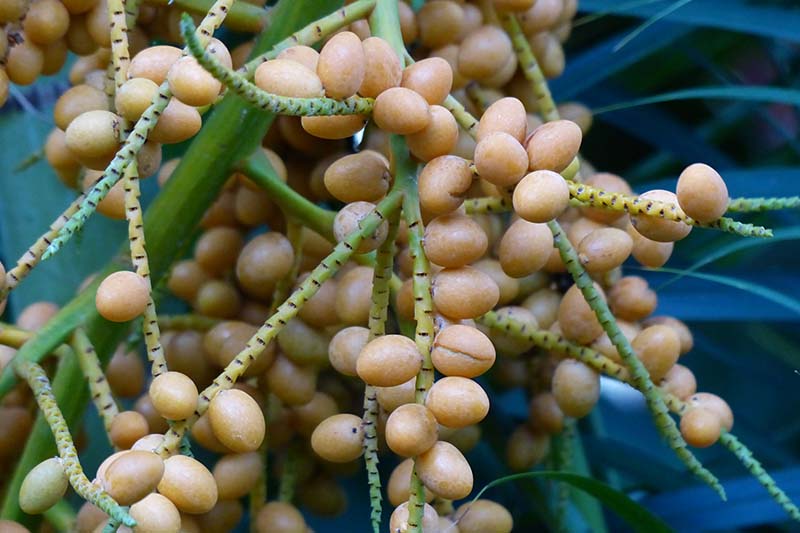
Through division
The division is a simpler and faster method of propagation. Get yourself a mature plant.
- The most significant time to divide is in the spring when new growth is beginning to emerge, although one can do it at any time of year.
- Watering the plant thoroughly the day before you want to divide it can help soften the soil and make it easier to separate the roots.
- Find a clump of three to five stems to divide from the parent, and gently loosen and cut the stems apart with a sharp knife in the soil around the stems, being sure to preserve all roots intact.
- You can remove the entire areca palm plant from its container. (Remove a piece of stems and their connected roots by shaking off the soil.)
- Plant the division in a new container with a palm potting mix, as described above, or a two-to-one mixture of conventional potting soil and coarse sand for added drainage.
- Water the division thoroughly after repotting it, then return the parent plant to its original container or repot if required.
- Before fertilizing, water thoroughly and wait at least three months to see desired results.
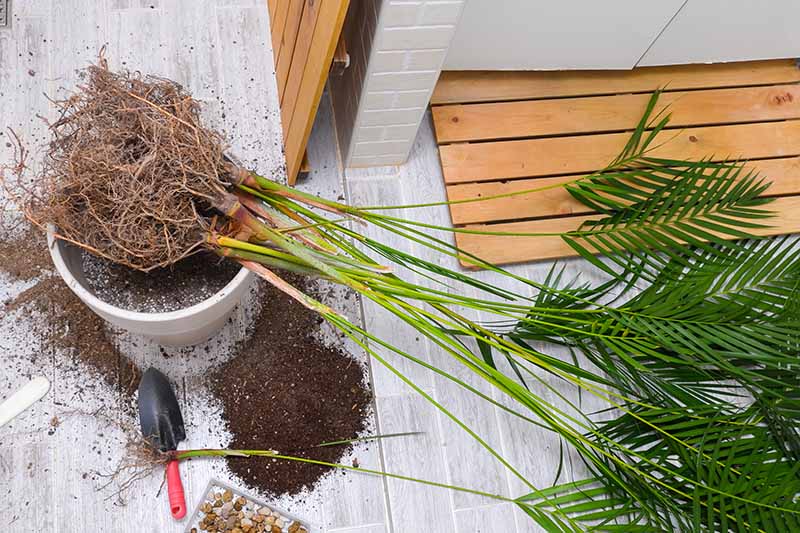
How to grow Areca palm indoors?
When growing an areca palm plant indoors, give it a comfortable large pot, but not too huge, because the palm prefers to be a little root-bound. Planting your plant indoors will also prevent the palm from becoming too tall.
Note for areca palm plant care:
- Repotting is only necessary every two to three years, so there is no need to transplant the palm more frequently as long as it is healthy.
- Pruning or clipping the palm down can injure the young fronds since areca produces new growth from the core of the plant. You can clip the tips of the leaves if they get brown and ugly, but you should never trim fresh growths because this would stunt the plant’s growth.
We have already discussed propagation and how to grow your areca palm plant. Next, we will dive into care instructions for the areca palm tree.
How to care for Areca Palm?
Areca palm maintenance is simple, but the plant will not accept any neglect.
- When growing an areca palm tree outdoors, it’s crucial to immediately keep it in a well-drained location. Wet soil can cause root rot. You will need a well-draining container if you are keeping it indoors.
- Plan to water your plant whenever the soil begins to dry out for regular maintenance. It is especially helpful for keeping outdoor palms healthy in hot weather.
- Furthermore, indoor palms frequently don’t get enough light unless you have a very bright window. As a result, bringing your palm outside in the summer to be exposed to diffused sunshine can benefit your palm.
- Pruning and trimming aren’t required for these palms. Wait until the leaves are primarily brown before removing them, as they can still contribute to photosynthesis.
Now, we will cover these in detail.
1) Light
Bright indirect sunshine is ideal for the Areca Palm plant. It dislikes low-light environments. Your Areca Palm’s leaves will turn yellow and wrinkle if it doesn’t get enough sunlight.
It doesn’t like it if your Areca Palm gets too much sunshine, especially direct sunlight. Sunburns will occur if your Areca Palm receives too much sunshine.
Note for areca palm plant care:
Unfortunately, the sunburns on your Areca Palm do not heal and do not return to their original hue. You can prune these leaves if you don’t want to see the sunburns any longer.
Many gardeners struggle to find a place with adequate lighting, as the Areca Palm requires a lot of strong sunshine but will not thrive in indirect light, which causes the leaves to be yellow. You should place it on a windowsill with plenty of natural light, and direct sunlight should be filtered with shades or drapes if necessary.
While this plant isn’t difficult to grow, it does have some unique requirements. The plant will struggle to develop and live if it does not receive enough of the appropriate light.

2) Soil
The Areca Palm plant care requires damp soil that is kept moist for most of the year. A mixture of peat moss, potting soil, and perlite will be ideal for your plant’s growth. The ideal soil can maintain its shape, retain moisture for a few days, and swiftly drain excess water. You’ve also found an excellent solution if you can locate pre-mixed palm soil.
Note for areca palm plant care:
If you use regular potting soil for this plant, the soil compacts quickly if you water it frequently. You must avoid compacting the soil because it will prevent oxygen from reaching the palm’s roots. Root rot can develop when the roots of your palm are deprived of oxygen. Because this plant’s stems don’t hold a lot of nutrients, root rot is likely to kill it.
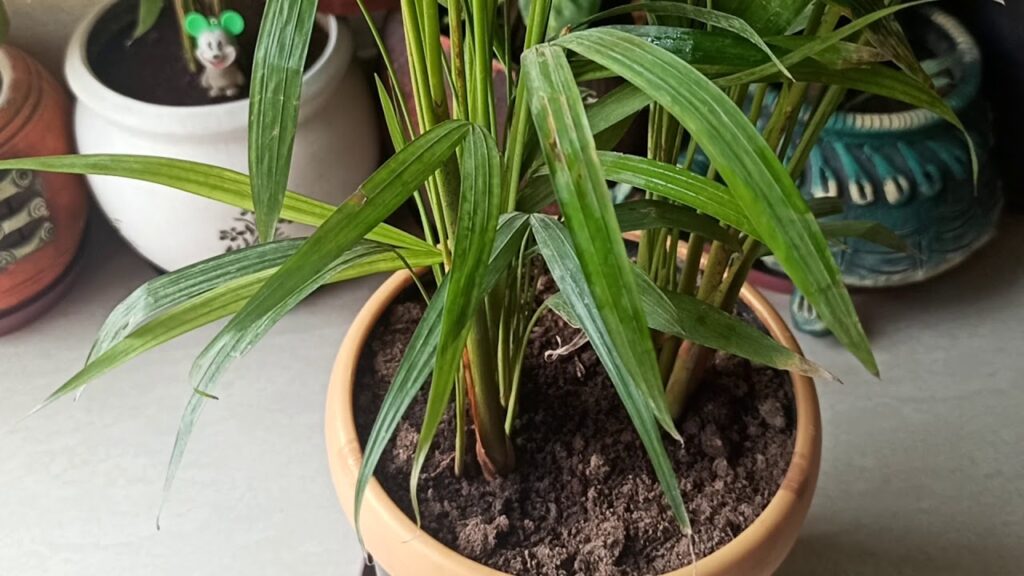
3) Water
If you are wondering how to water areca palm plant, we got your back! The Areca enjoys damp soil, which is similar to its natural environment. You should water your palm plant at least twice during the spring and summer. It is in the growing season during the spring and summer, and it consumes a lot of water and nutrients.
You should adjust your watering schedule and water the areca less frequently in the fall and winter. In the summer, you should water your Areca once a week to every ten days in the fall and winter.
Note for areca palm plant care:
It’s easy to overwater your palm in the winter, so make sure the soil is dry before watering your plant. Wait a few days and check again if the soil is still wet at this point.

4) Temperature
The areca palm plant thrives in temperatures between 65 to 75 degrees Fahrenheit, which are typical for residential conditions. You should keep it away from doorways and other areas where cold drafts could occur. The plant should not be allowed to sit in temperatures below 55 degrees Fahrenheit, and rapid temperature drops will harm the plant, resulting in brown spots on the leaves.
5) Humidity
This plant thrives in the regular humidity found in houses and requires no further care. The only time you should make an attempt to enhance humidity around the areca palm plant is if the air in your home is extremely dry.
Note for areca palm plant care:
- The browning of the leaf tips might be caused by dry air. You can avoid this by spraying the plant lightly with water.
- Alternatively, you can place the plant in a tray of pebbles with water surrounding it. The humidity levels around the plant will increase as the water evaporates.
6) Fertilizer
Because the palm plant is a heavy feeder, it needs to be fertilized with fertilizer from spring to early fall. When the palm plant is dormant in the late fall and winter, don’t feed it.
During the growing season, use a liquid houseplant fertilizer like 12-4-12 (NPK) two or three times, diluting to roughly half the recommended concentration.
Note for areca palm plant care:
They are sensitive to fertilizer salts, and buildup on the foliage can cause discoloration or patches.
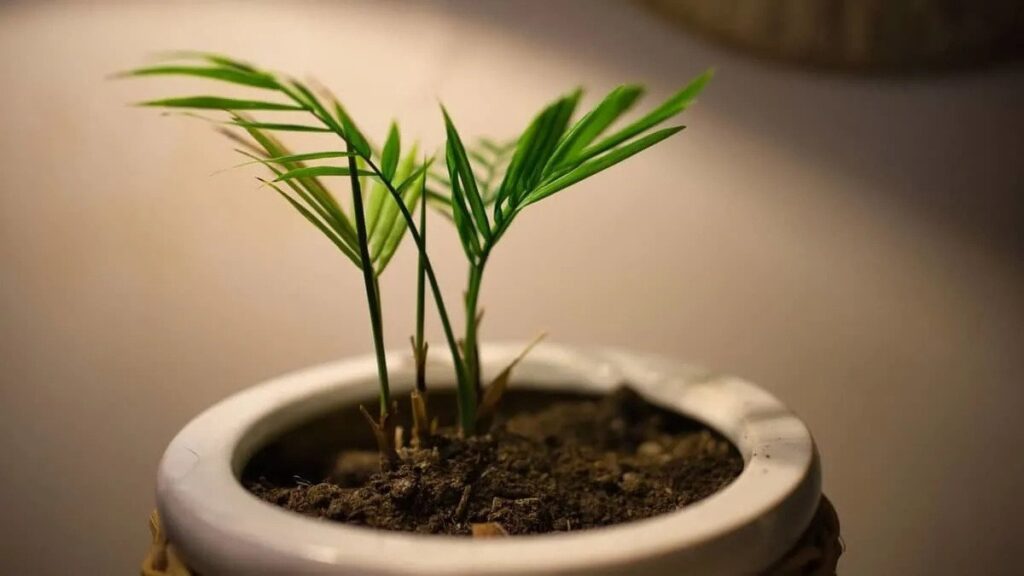
7) Repotting
This plant doesn’t need to be potted very often because it thrives in its current container. It prefers a tight-fitting container for its roots, which will also assist in limiting the plant’s size. Re-potting is always a good idea to freshen up the soil that the plant is sitting in.
You can repot this plant every three years or more frequently if your Areca Palm appears to be struggling due to being pot confined. Because the Areca Palm’s lifespan is just about ten years, some individuals get away with not repotting it.
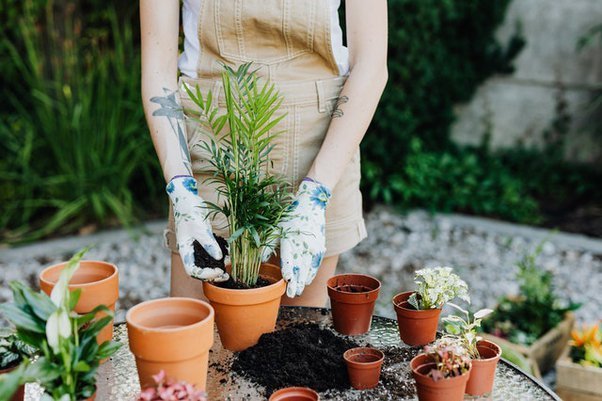
Areca Palms are potted in clumps, and as they mature, they might establish their own clumps.
Steps for repotting the plant:
- To repot the palm, carefully remove it from its existing soil while being careful not to damage the root ball.
- Areca palm plant may suffer in its new pot if you disrupt the roots too much, so be cautious.
- Choose a larger pot than the one you’re presently using and pot your hand into it, making sure the root ball is buried at the same level as it was in the previous pot.
- Make a note of where the earth previously came up to on the stems, and make sure the fresh soil doesn’t go much higher.
Note for areca palm plant care:
- If the plant has been ailing as a result of salt and fluoride buildup, repotting it in new soil will be very beneficial.
- You can use a palm-specific potting soil or a combination of ordinary houseplant potting soil and a handful of builders’ sand for the new soil.
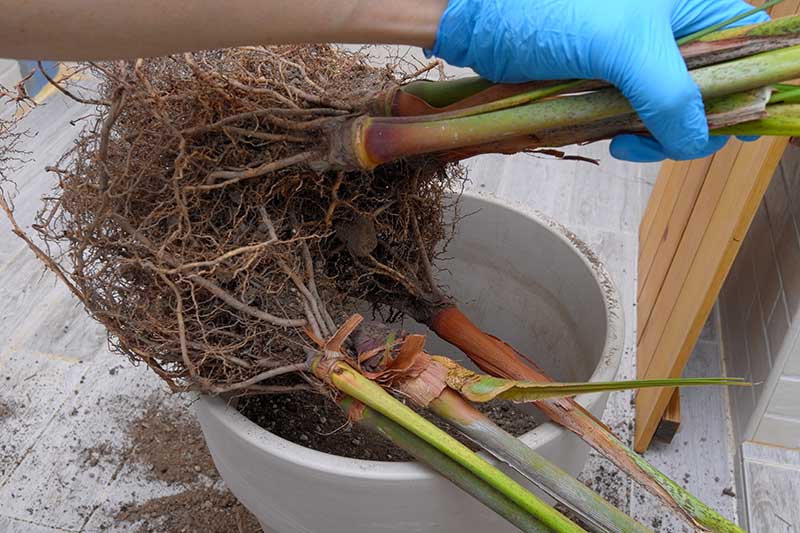
8) Pruning
Pruning should be done sparingly to remove browned fronds or dead or diseased canes. Browning tips on the leaves are a normal part of the plant’s life cycle and should not be cut because it would hinder its growth.
You should eliminate removing healthy canes that seem golden in color. Remove a little bit of the outside bark off a cane to see if it’s dead.
If the cane is certainly dead, you can safely clip it if it is dark brown in color. With a sharp pair of garden shears, cut off dead canes at the base.
Common Pests & Diseases
Leaves that are turning yellow
Areca palm plant turning yellow is not a new concept. Yellow leaves on the Areca Palm plant are unusual, and they usually signify that the plant isn’t getting enough water. Give your plant more frequent waterings to remedy this, and it should recover soon.
Yellow to brown spots
If only a few locations on your palm’s leaves are turning yellow, it’s most likely due to low potassium levels in the soil or a high acidity level in the soil. Adjust your fertilizer to try to balance out the levels, then re-pot the plant if necessary to start over with fresh soil.
Brown tips
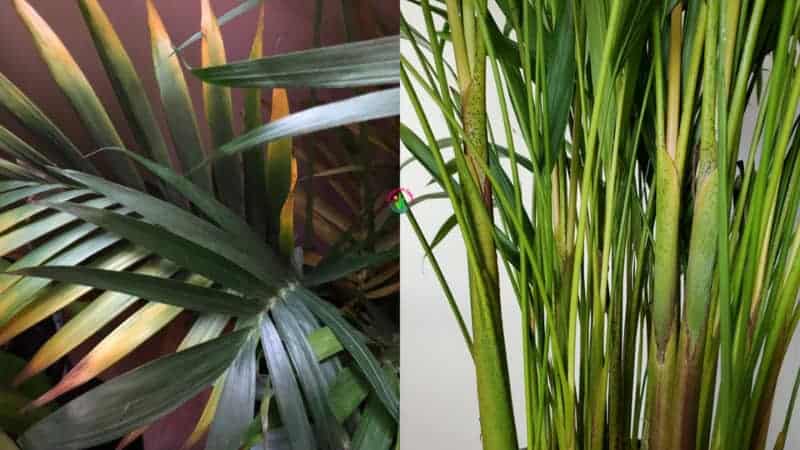
Brown tips are frequently produced by cold breezes or dry air, not by a lack of water. Determine what is causing the browning of your plant’s tips using a process of elimination, and take action accordingly. To boost humidity, move the areca palm plant to a more secluded location away from chilly drafts or spritz it with a misting water spray.
Spots or brown leaves
Brown leaves on the plant’s underside are not an issue; they are a natural occurrence, and cutting or allowing them to fall off will encourage new development. Brown leaves on the plant are a cause for concern and are usually the result of overwatering. If you feel this is the case, simply reduce the amount of water you give the plant, and it will recover soon. Before watering, make sure the soil is dry to the touch, and the problem should go away.
Brown leaves or brown spots on the foliage could be caused by a quick temperature decrease or too much fertilizer. If you reside where the water is hard, try watering your plant with bottled water or collecting rainfall to see if it helps. You can solve the problem by feeding the areca palm plant with a more diluted fertilizer or moving the plant away from cold drafts.
Rooting of roots
These are major issues that are induced by overwatering. Root rot can swiftly kill or severely harm a plant, rendering it unsalvageable. The greatest medication for root rot is prevention, which can be accomplished simply by installing a good drainage system and being careful not to overwater your Areca Palm.
Use well-draining soil and make sure your plant pot has drainage holes at the bottom to allow any excess water to drain. To avoid the plant sitting in water, you can empty the drip tray on a regular basis. Before adding more water, always test the soil to ensure that the plant is not overwatered.
Red spider mites

These are the parasites that eat the dust that collects on the Areca Palm’s leaves. When the humidity is low, dust tends to accumulate more; thus, keep the humidity high to avoid this problem. You can do this with an electric humidifier or by spraying the plant’s leaves with a misting water spray every now and then. If you already have a spider mite infestation, Areca palm plant care involves getting rid by sponging the leaves with soapy water.
Because spider mites are so little that they can only be seen with a magnifying glass, an infestation can often progress quickly before you realize it. The damage, which can include mottled yellow leaves, brown foliage, and stunted growth, is frequently seen before the infestation.
What else can you do?
- Place a piece of white paper under your areca palm plant and tap the leaves to see whether you have a spider mite infestation. If spider mites are present, they will fall out onto the paper.
- Take the plant outside and shower it with a vigorous water jet to treat a spider mite infestation. Repeat this process twice a day until the infestation is gone. If this doesn’t work, use neem oil or insecticidal soap instead.
Scales
Scale insects appear as small white lumps, round or oval in shape, with no distinguishing traits such as body sections. They live on the undersides of leaves, which can become whitewashed if the infestation is severe. They can attack a complete areca palm plant but are most common on a leaf, sucking the sap from the plant with their straw-like mouths.
What can happen?
Brown spots will appear on your plant’s leaves, as well as curled up, dropping leaves, and, finally, a dead plant.
There are various distinct forms of scale, and you must first determine which one you have before attempting to eradicate the infestation. Different types of scales respond to different treatments.
While most varieties of scale are only an annoyance to deal with, some are harmful and can swiftly kill a plant beyond the point where it can be salvaged. This scale is most typically found on palms resting in a swampy environment or having inadequate drainage. Another reason to avoid overwatering your palm is because of this.
Note for areca palm plant care:
- If you find a scale infestation on the leaves, don’t try to wash them off because this will only encourage future scale infestations. Instead, snip off the significantly impacted leaves and dispose of them properly.
- To thin out the plant and guarantee that all of the leaves have access to light, prune back different plant areas. Scale infestations are naturally controlled by prolonged exposure to sunshine at high levels.
- If more pest control is required, use a horticultural oil to keep the scale infestation at bay or introduce natural scale predators like lacewings, beetles, and ladybugs. Pesticides should only be used as a last resort to control scale since they can disrupt the natural balance of ‘good’ insects.
Mealybugs
Mealybugs appear as a fluffy white substance on your plant and live in the nooks and crannies of your plants, making them tough to notice and remove. They rob the areca palm plant of crucial nutrients and produce a sticky residue that eventually becomes black. Mold is the black residue, and you should eliminate it with caution.
Mealybugs are normally eradicated by spraying them with a high-pressure water stream. Spray your palm tree with a water hose outside, concentrating on areas where mealybugs may be lurking. If this doesn’t work, you can remove the mealybugs with tweezers or wipe the leaves with rubbing alcohol.
Whitefly
The adults are white-winged creatures that fly away as soon as you disturb the leaf, while the baby whiteflies seem like scale insects. They live on the undersides of leaves, sucking the plant’s sap and jeopardizing its health.
After feeding on the sap, whiteflies release a sticky material that is left on the leaf. It will transform into a black soot-like substance, which is actually a fungus. If you have a whitefly problem, you’ll almost certainly have an ant problem as well because ants are drawn to the sticky substance left behind by the whiteflies.
What to do in this situation?
- To combat a whitefly infestation, spray the areca palm plant outside with a powerful stream of water first. Spraying the undersides of leaves twice a day until the infestation is gone can be done till the infestation is gone.
- Placing yellow sticky tape near the plant, on the other hand, is usually quite effective at removing whiteflies, as the adults are attracted to yellow and become caught on the tape.
Frequently Asked Questions
Ques1: How tall does an areca palm plant grow?
Areca palms can reach a height of six to ten feet when grown indoors. They can reach a height of 15 to 20 feet when grown outdoors. Areca palms feature airy, arching fronds that are wider at the top and can be two to three feet in diameter. Areca palms grow eight to ten inches per year and live for roughly ten years on average.
Ques2: Should I water my areca palm plant with filtered water?
Yes, you should water your areca palm with filtered water rather than tap water. Minerals, notably fluoride, which are commonly found in tap water and can cause discoloration, are toxic to these plants. If you reside in a region where tap water contains a lot of fluorides, you should either use filtered or distilled water or, if feasible, water your areca palm when it rains.
Ques3: Is it necessary to repot an areca palm on a regular basis?
One should repot the areca palms every two to three years. It can help you control the size of your plant, which is beneficial if you just have a small amount of area. Repotting in new soil may assist if your areca palm is ailing due to mineral buildup. Remove the palm from its existing soil, be careful not to damage the root ball, and repot it in a new pot size larger than your current pot. Place the root ball in the same position as it was in its last pot.
Ques4: Are the areca palm plant toxic to pets and children?
The Areca Palm, like other palms, is not poisonous to cats, dogs, or people. This plant is safe to keep near your pets and children, and you won’t have to worry about doctor visits. It will not damage your pets or small children if they eat your plants, but you should keep it away from them.
Conclusion
Areca palm plant requires little attention, and beginners can adapt to them as well. It gives an appealing tropical vibe and can steal the charm of your home. What are your plans regarding this tropical vibe plant?
Tell us in the comments section if you have any questions regarding the areca plant.
Related Articles
- Propagating Chinese Elm Bonsai Cuttings And From Seeds
- Best Chinese Elm Bonsai Soil and Fertilizer.
- Troubleshooting Common Problems With Chinese Elm Bonsai
- Buy Chinese Elm Bonsai: How Not to Get Scammed When Purchasing a Chinese Elm Bonsai Tree!
- Chinese Elm Bonsai Pruning And Styling.
- Creating a Chinese Elm Bonsai Forest- Step-By-Step Guide.


